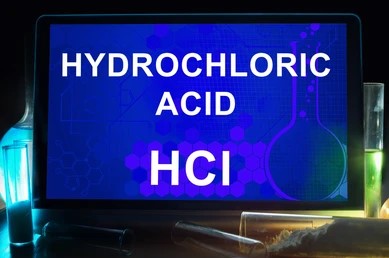Hydrochloric acid, also known as muriatic acid or chlorohydric acid has many uses. It is used in the production of chlorides, fertilizers, and dyes, in electroplating, and in the photographic, textile, and rubber industries.

Hydrochloric acid, often abbreviated as HCl, is a highly corrosive, strong mineral acid with various industrial, commercial, and laboratory applications. It is a colorless, pungent-smelling solution of hydrogen chloride gas dissolved in water.
Grade | Extra Pure |
Purity | 37% |
CAS No. | 7647-01-0 |
HS Code | 280610 |
Molecular Formula | HCL |
Molecular Weight | 36.46 |
Shelf Life | 60 Months |
Grade | Extra Pure |
Purity | 37% |
CAS No. | 7647-01-0 |
HS Code | 280610 |
Molecular Formula | HCL |
Molecular Weight | 36.46 |
Shelf Life | 60 Months |
|
Appearance |
A clear colorless fuming liquid |
|
Assay (acidimetric) |
36.5 – 38.0% |
|
Weight/ mL at 20°C |
1.183 – 1.189 |
|
Non-volatile matter |
Max 0.01% |
|
Free chlorine (CI) |
Max 0.0005% |
|
Sulphuric acid (H2SO4) |
Max 0.02% |
|
Iron (Fe) |
Max 0.001% |
|
Lead (Pb) |
Max 0.0005% |
Appearance | A clear colorless fuming liquid |
Assay (acidimetric) | 36.5 – 38.0% |
Weight/ mL at 20°C | 1.183 – 1.189 |
Non-volatile matter | Max 0.01% |
Free chlorine (CI) | Max 0.0005% |
Sulphuric acid (H2SO4) | Max 0.02% |
Iron (Fe) | Max 0.001% |
Lead (Pb) | Max 0.0005% |
Hydrochloric acid is widely used in the chemical industry for the production of various chemicals including chlorine, PVC (polyvinyl chloride), fertilizers, and pharmaceuticals. It serves as a key raw material in numerous chemical synthesis processes.
Hydrochloric acid is widely used in the chemical industry for the production of various chemicals including chlorine, PVC (polyvinyl chloride), fertilizers, and pharmaceuticals. It serves as a key raw material in numerous chemical synthesis processes.
Hydrochloric acid is approved for use in food processing applications, primarily as a food additive for adjusting acidity levels and enhancing flavor. It is utilized in the production of various food products such as soft drinks, canned goods, and cheese.
Hydrochloric acid is highly corrosive and can cause severe burns and tissue damage upon contact with skin, eyes, or mucous membranes. Personal protective equipment (PPE) including gloves, goggles, and protective clothing should be worn when handling hydrochloric acid.
When concentrated hydrochloric acid comes into contact with certain metals or organic materials, it can release toxic fumes of hydrogen chloride gas. Proper ventilation and respiratory protection are essential to prevent inhalation of these fumes.
In the event of a spill, neutralizing agents and absorbent materials should be used to contain and clean up the acid. Neutralization reactions should be performed cautiously to avoid hazardous chemical reactions.
Whether you’re looking for raw materials for your manufacturing process or specialized chemicals for your industry, we’ve got you covered. What can we assist you with?